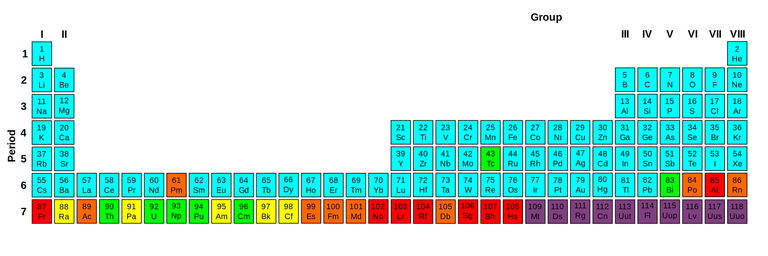The periodic table is a table that hows the position of the elements and across the 118 elements on this table, 90 elements occur naturally on earth and we have a lot of elements in our body than we know because we are not aware of them. We give a lot of credit to just a few elements which include Carbon, Oxygen, Hydrogen, Sulphur, Phosphorus, and Nitrogen, and they can either exist individually or as pairs of atoms.
They exist in so many forms from as simple as Water (H2O) to everything else. Since humans are more of water that other things, it means we are made up of hydrogen based on atom and oxygen based on Mass. Asides from the previously mentioned atoms, there are other atoms that are not rare but aren't usually credited for keeping us alive, and they are Chlorine, Magnesium, Sodium, Calcium, and Potassium. These atoms do a lot when it comes to keeping neurons in the body firing, as well as contraction keeping bones strong, and the relaxation of muscles.
Both the 6 major atoms, and the 5 not popular atoms make up 99.9% of the elements in our body, but they do not make up all the elements because the remaining 0.1% is made up of up to 50 elements and these elements are regarded as Trace Elements and they are Iron, zinc, iodine, silicon, uranium, lead, and so on. Most of them gotten from the environment.
Identifying bio-essential elements are still up for a debate and some scientist refer to it as being elements that organisms cannot survive without, and is involved in the building and breaking down of molecules, while some say that for an element to be bio-essential, it needs to be present in human tissues, and when it is absent it can cause harm, but when the element is reintroduced it would stop the damage caused by its absent.
Asides from the first 11 elements, there are still about 12 to 14 other bioessential elements that are not as prominent as the first eleven. In the bloodstream, we have about 5 grams of iron in it, found in the hemoglobin of the red blood cell. The hemoglobin has a job of carrying oxygen around the body via the bloodstream but then the oxygen get stuck to the iron atom in the hemoglobin which is then passed to irons in the muscle tissue which then sends carbon dioxide to the hemoglobin which sends it to the lungs.
Asides from hemoglobin, there are over 500 different protein that the body uses iron. While iron isn't always mentioned as an important element, not having in the body can lead to anemia which comes with symptoms such as fatigue, dizziness, weakness, dry skin, headache, cracked lips, pallor, insomnia, and other symptoms of anemia. So when you think iron isn't important in the body, remember that not having that element can lead to anemia.
Copper is another trace element in the body. It is made in the liver and carried around in a molecule known as Ceruloplasmin and it is delivered to the blood were it helps hemoglobin to function. It is also important in the production of collagen and melanin in the skin, it helps with bone strength. It is also very important in maintaining the myelin sheath outside the neurons (the neurons are responsible for the electrical signals in the brain and the nerve) so when there is copper deficiency, it comes with symptoms similar to iron deficiency as well as nerve issues. It is very rare to have copper deficiency as it is present in shellfish, meat, mushrooms, nuts, and many other foods that we eat. That said, unless a person has very rare diseases like Wilson's disease, there is no need to worry about copper.
While eating the blue or red looking cobalt is toxic, we have cobalt in our body especially in our gut. This is gotten from a group of vitamins known as Cobalamins with an example being cyanocobalamin (vitamin B12) and they can be found in food. This element play roles in proteins for red blood cells, fatty acids, DNA and it is important in nerve functions. Our body cannot make make vitamin B12 instead we get it from other sources.
Let's talk about the element with the atomic number 42 which is present in the body. You are asking what element is the number 42? It is Molybdenum. It is responsible for the break down of toxins and waste. While it might look insignificant, people who do not make this protein suffer extreme seizures and can lead to death in infancy.
When next you are thinking of mentioning just the top eleven macroelements in the body, remember that trace elements like Iodine, Zinc, Fluorine, Boron, and lots of other elements are present in the body and they are bio-essential.
Read More
https://www.news-medical.net/life-sciences/
https://www.thoughtco.com/elements-in-the-human-body-p2-602188
https://www.researchgate.net/publication/48855095_Ultratrace_minerals
https://www.ucsfhealth.org/education/hemoglobin-and-functions-of-iron
https://www.mayoclinic.org/diseases-conditions
https://www.ncbi.nlm.nih.gov/pmc/articles/PMC549063/
https://www.ncbi.nlm.nih.gov/pmc/articles/PMC5637704/
https://www.sciencedirect.com/science/article/abs/pii/S0162013418306846?via%3Dihub#s0080
https://www.sciencedirect.com/science/article/pii/S002231662210636X?via%3Dihub
https://www.ncbi.nlm.nih.gov/pmc/articles/PMC7601760/
https://www.hsph.harvard.edu/nutritionsource/molybdenum/
https://www.cdc.gov/niosh/topics/cobalt/default.html
https://chem.libretexts.org/Bookshelves/General_Chemistry
https://www.ncbi.nlm.nih.gov/books/NBK218751/
https://www.ncbi.nlm.nih.gov/pmc/articles/PMC6361146/


